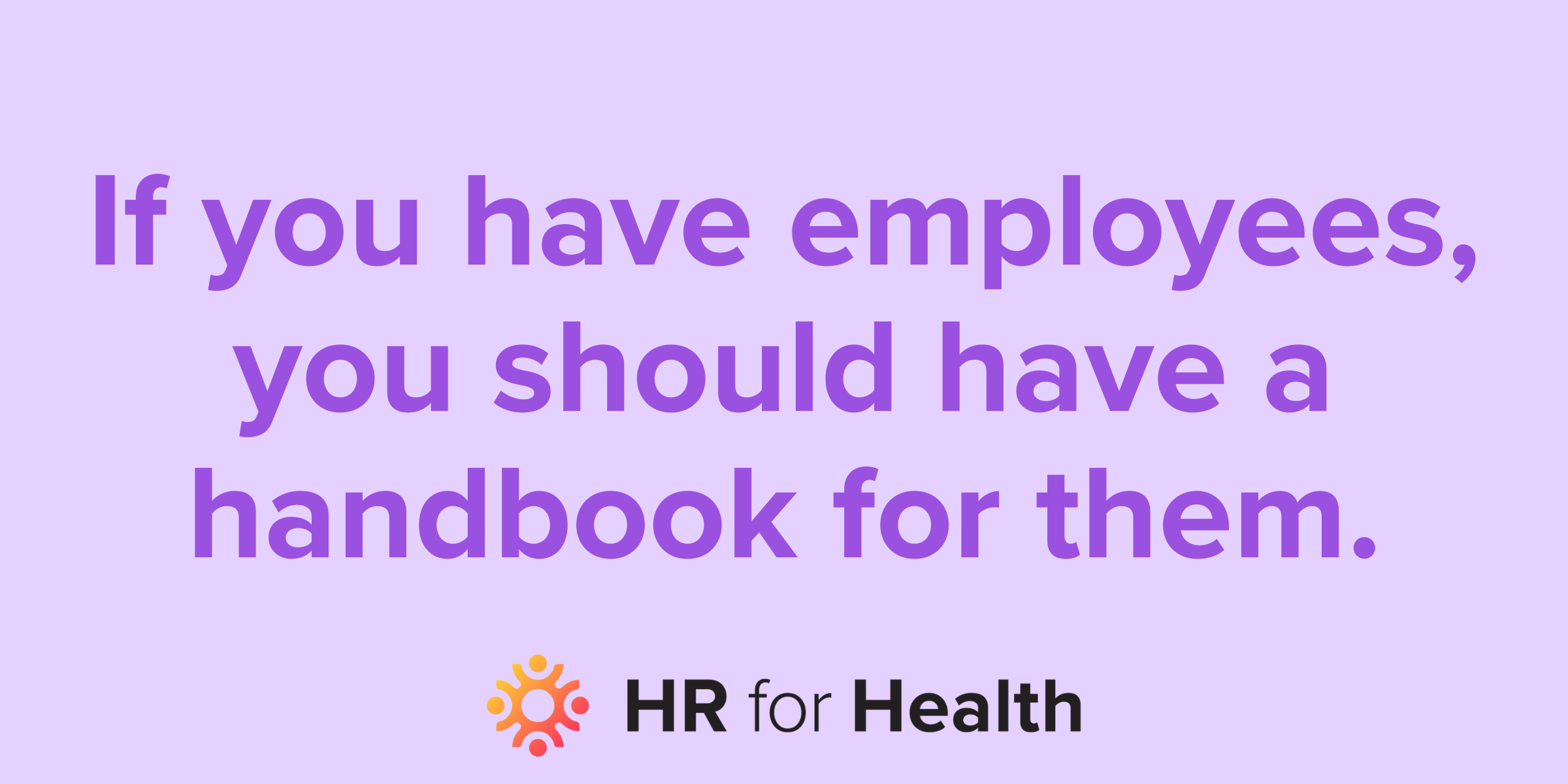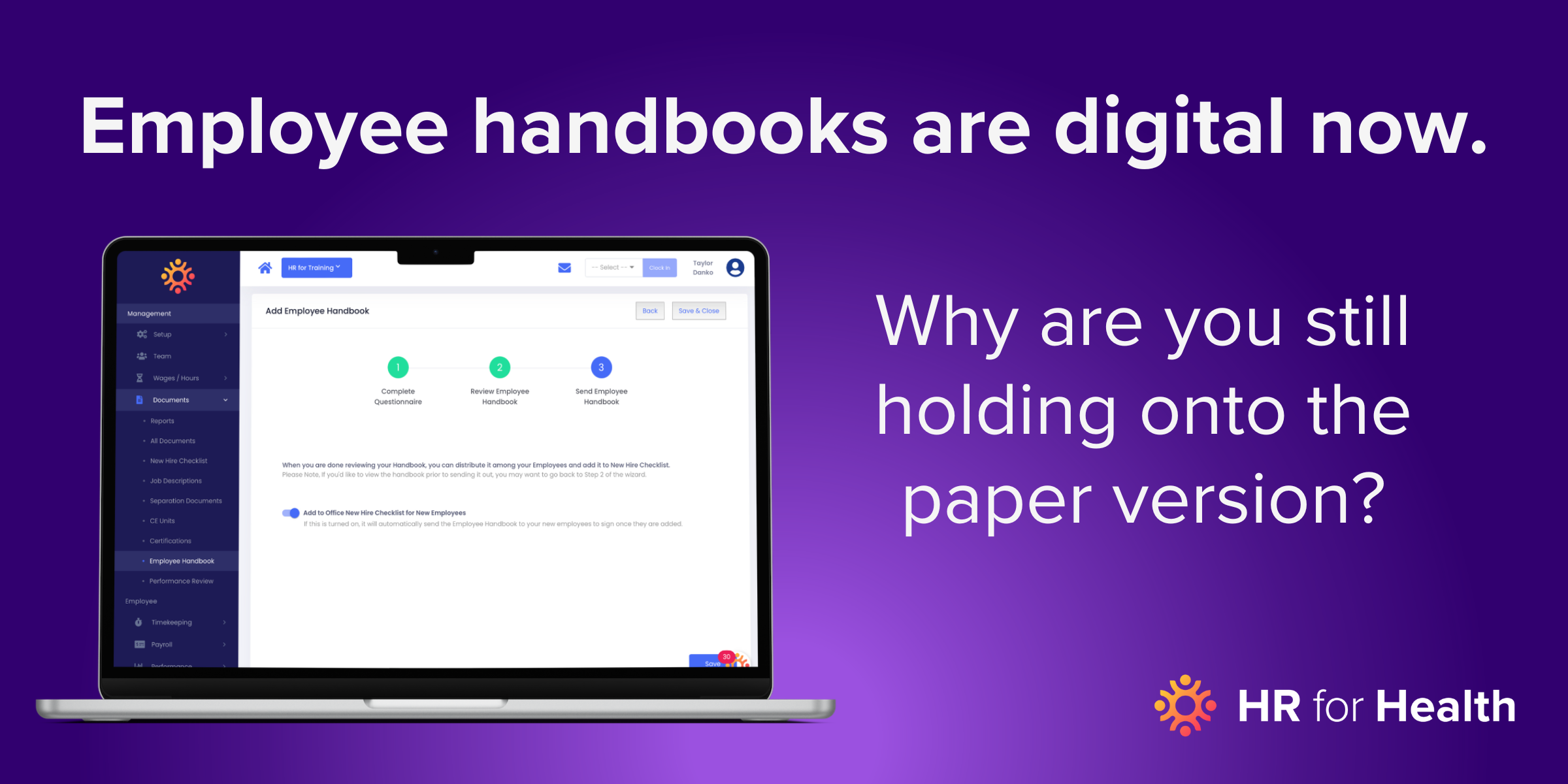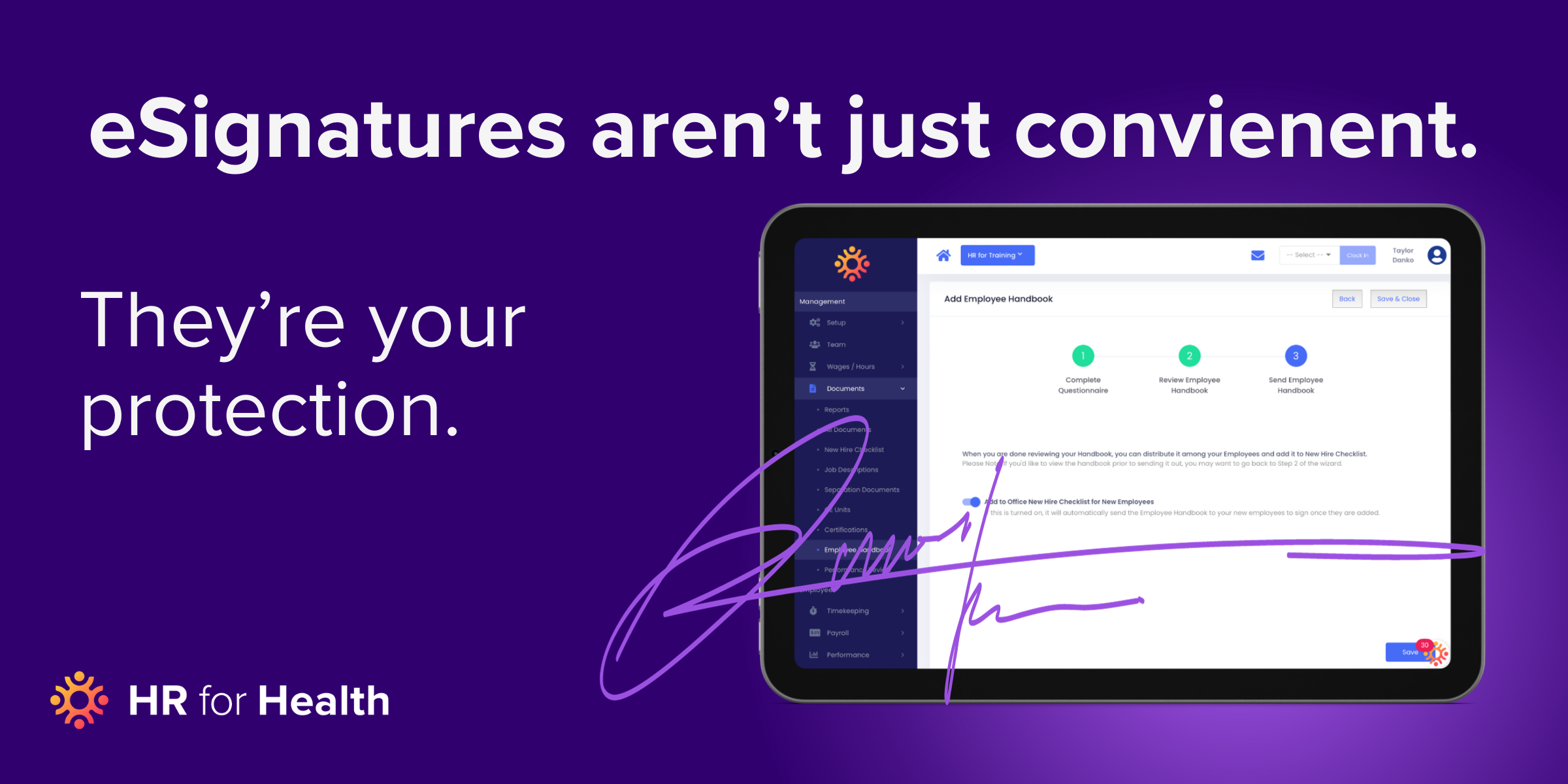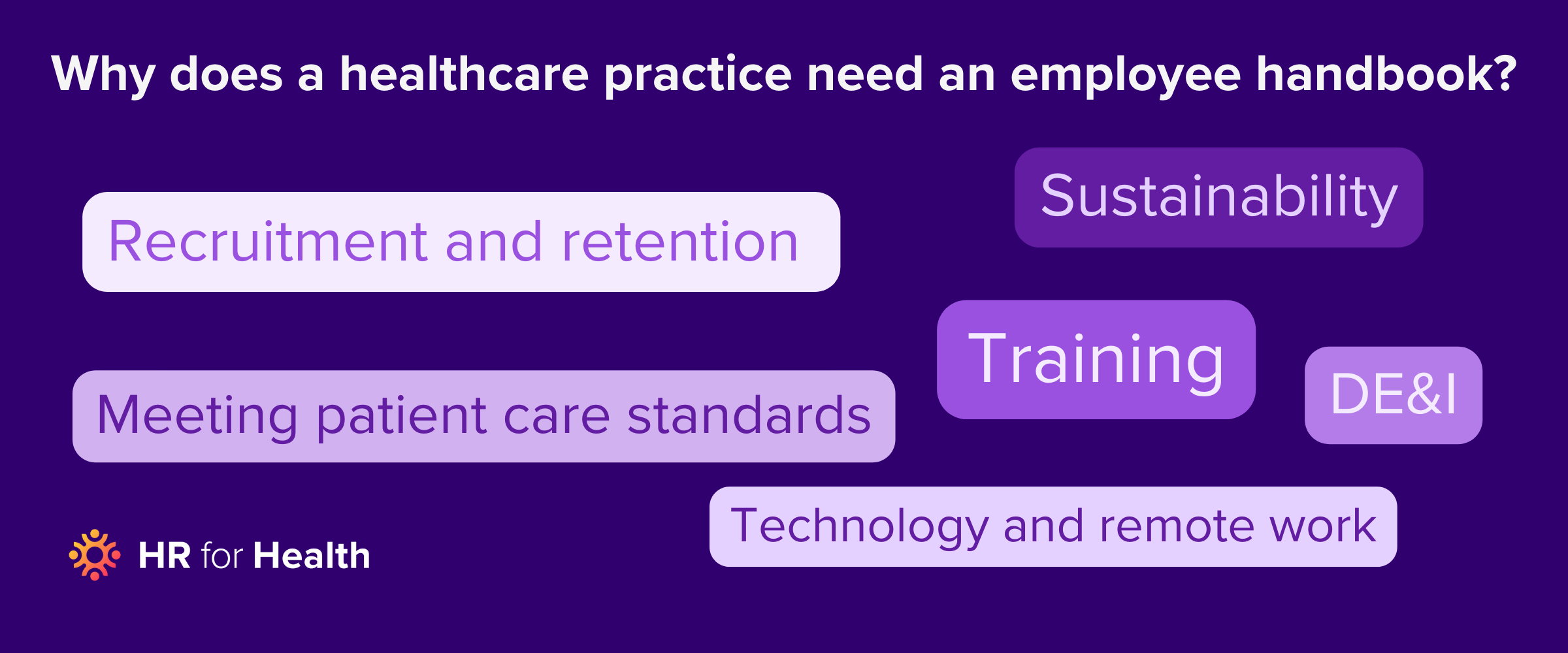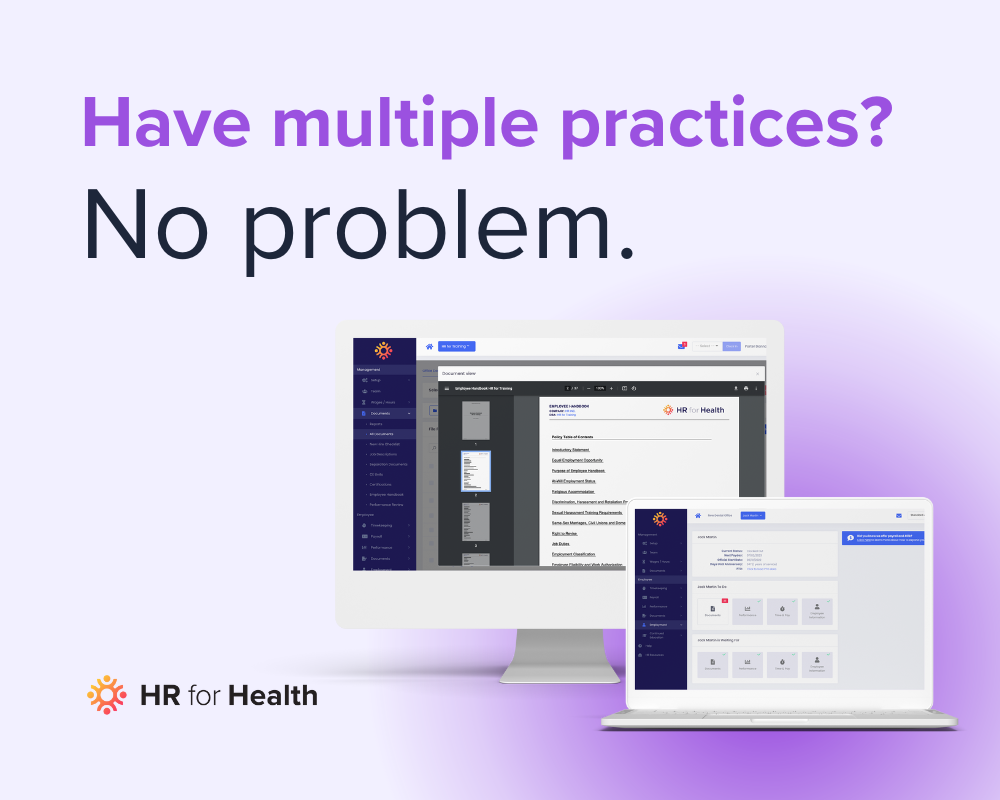Your employee handbook is one of the first things you can hand to your new hires. It’s more than a training manual, though. This is your practice’s time to shine. This introductory document can answer your employees’ questions, establish expectations, get ahead of disputes, and set your employees up for success – all in one fell swoop.
Creating one of these crucial documents may seem like just another bureaucratic headache, but it doesn’t have to be overly complicated. In fact, it shouldn’t be. Here’s what you need to know about creating the best employee handbook for your healthcare practice.
Table of Contents
- What is an employee handbook?
- 3 Reasons not to skip creating an employee handbook
- What is included in an employee handbook?
- So, is an employee handbook a legal document?
- Employee handbook vs. employment contract
- Is having an employee handbook a legal requirement?
- Is an employee handbook a one-and-done document?
- Potential problems with generic or re-used employee handbooks
- How can an employee handbook protect your practice?
- Quiz: Do you need an employee handbook?
- Creating Your Employee Handbook
- Human resources and healthcare
- Which medical practices need an employee handbook?
- What if you have multiple practices?
- How much does an employee handbook cost?
- Step-by-step: How to create your employee handbook
- How HR for Health Can Help
What is an Employee Handbook?
Let’s get this out of the way: an employee handbook is a lot more than just a welcome packet.
This is your opportunity to welcome your employees to your practice, yes, but this is also the moment to set expectations, establish do’s and don’ts, provide details on what is and is not within job descriptions, and make sure everyone is onboard with compliance.
We know, this doesn’t sound a lot like providing patient care (and that’s the whole reason you got into this line of work, isn’t it?) but stay with us here. Human resources is critical, and it’s not something you want to put on the back burner. You really do need an employee handbook – not just to help your employees stay on the straight and narrow, but to make sure your practice stays legally safe.
3 reasons not to skip creating an employee handbook
- Policies
- Processes
- Protection
Recommended Reading: What is a handbook?
Policies
Your employees need to know what to expect, what your practice stands for, and how you operate. Providing this information in black and white and making sure it stays relevant keeps everyone working toward the same goals.
Processes
Create consistency across your organization to stay productive and get ahead of your employees’ FAQs. You’ll discover that a fair amount of their HR-related questions can be included in the handbook, so they can refer to this document anytime to double-check their rights, benefits, and company-related questions.
Protection
Your employee handbook is your opportunity to demonstrate how you intend to comply with the laws, regulations, and all relevant statutes. Establishing this information early and effectively can help keep you out of legal hot water.

What is Included in an Employee Handbook?
An employee handbook definitely covers the legal basics, code of conduct, etc. But it also covers some of the more fun stuff like vacation and professional development opportunities. Generally speaking, your employee handbook contents should cover:
Employee expectations
- Code of conduct
- Company rules and policies
- Employment description and terms
Your company’s mission and core beliefs belong front and center so that your employees are aware of your practice’s ultimate goals.
The handbook should cover basic policies and procedures like role descriptions, attendance and time tracking, alternative work schedules, dress code, and the ways your employees are expected to interact with each other and patients. If you have a disciplinary structure, this is where you would include it. Keep these things general, though, because specific employee handbook examples could create unintentional loopholes. Do provide information about performance reviews and measurements.
Employer expectations
- Compensation and payroll
- PTO, benefits, and perks
- Employee resignation and termination information
Your employees should understand when and how they can expect to be paid. Your employee handbook can outline pay structures, bonuses, overtime, and guidance about work schedules and absences. Your employees should know what to do if they need to take time off for sick days and PTO, holidays, or other reasons.
If you offer insurance, retirement, a 401K, childcare, maternity leave, or other benefits, this is the time to mention them.
The mandatory at-will employment statement indicates that as as long as everyone’s operating within the confines of the law, employees can quit or be let go at any time.
Laws and regulatory requirements
- Worker’s compensation
- Laws and provisions pertaining to disabilities, harassment, and discrimination
- Patient safety and care procedures
In the event that an employee becomes injured on the job or is exposed to harmful chemicals or diseases, they’ll need to know how to file a claim – and you’ll need to know what to do, too.
Qualified employees will need to be provided with reasonable accommodations for disability, pregnancy, health conditions, and other limitations.
Patient health information is sensitive, and it’s essential that your employees adhere to those privacy laws. Protections like communication methods, safety procedures, and standard of care delivery processes should be outlined here.
Remember to collect signatures
It’s all well and good to have created a handbook that covers this information, but if your employees don’t sign and acknowledge that they’ve had an opportunity to review it and ask questions, it holds no power. In other words, don’t forget to collect those receipts.
Here’s what’s not included in an employee handbook:
- Things you can’t enforce. Some things are just out of your hands. Regardless of employer, it’s within employees’ rights to discuss wages, work issues, and have personal discussions that may not cast you in a flattering light.
- Things that may be inconsistent. The way you enforce certain lines in your handbook have to be applied to every employee in the same way. Inconsistency is bad for morale, devalues your handbook, and can even lead to discrimination suits.
- Employee-specific or role-specific content. The employee handbook is for everyone. You don’t need to describe each and every employee’s pay schedule and job description here – that’s for the employment contract. Just a general job description will do.
- Too much detail. If you get too far into the weeds with examples, you could create unintended loopholes or contradictions.
- Incomprehensible legalese. The best employee handbook is a straightforward document that all your employees can read and understand. Use plain language and don’t try to hide anything between the lines.
Recommended Reading: Guide to Employee Handbook Updates
So, is an Employee Handbook a Legal Document?
We highly doubt you intend to be non-compliant with laws and regulations. But unless you’re keeping your thumb on the pulse of updates in local, state, and federal HR policies (and if you’re trying to run your practice, you probably don’t have the time) you might be non-compliant.
And while an employee handbook isn’t a contract, it can be used in a court of law. It allows you and your employees to be fully aware of the policies, procedures, and regulations that you’ve agreed to follow. In the event that you run into legal entanglements, you can use your handbook to show that you’ve provided all the necessary information and your employee has acknowledged these things right from the get-go.
Employee handbook vs. employment contract
Your employee handbook should not be confused with an employee agreement. An employee agreement (or employment contract) outlines the terms of your employment relationship and is customized for each employee. A handbook is an umbrella document of core policies and expectations and it applies to all your employees.
If this differentiation isn’t crystal clear in your employee handbook, be sure to include a statement that explicitly states that it is not a contract.
Is having an employee handbook a legal requirement?
Technically, no. The long arm of the law won’t strike you down for not having an employee handbook, but skipping this step is not a very good idea. It’s always best practice to have an employee handbook – no matter if you’re running a large corporation, putting together a startup, or leading a small healthcare practice. In short, if you have employees, you should have a handbook for them.
Note that you are legally required to provide employees with certain information:
- Anti-harassment and anti-retaliation clauses
- At-will employment statement
- Details about time off, sick leave, breaks, and other rights
- State-governed employment laws and employee protections
This comprises a good chunk of a standard employee handbook. If you’re providing these bare essentials, you’re partway to writing your employee handbook anyway, so you might as well create the whole document.
Recommended Reading: Is an employee handbook required in California?
Is an Employee Handbook a One-and-Done Document?
This is one of the biggest traps employers fall into – thinking that once they’ve created an employee handbook, it’ll last for as long as their business stays alive.
A frightening number of clinics have outdated employee handbooks cluttering up their filing cabinets. Everyone forgets about those documents… until a lawsuit crops up.
Treat your employee handbook like the living document it is. Regular reviews, updates, and revisions of your employee handbook contents will keep you compliant and protected from avoidable disputes. If you use HR for Health software, these updates require little to no effort on your part, so you can focus your energy on running your practice.
Best practices for employee handbook revision
Laws change all the time. Expect to update your employee handbook at least once each year, but it’s better to review your handbook more often. In order to stay compliant at all times, it’s good to do additional reviews to catch laws that update over the course of the year.
Larger practices should be even more aware of these changes, since more laws apply to employers with a high number of employees.
Best practices for employee handbook use and distribution
Every time you refresh your employee handbook, take a moment to collect new signatures from your employees. They’ll need to know what’s been updated so they can stay compliant, ask questions, and understand the more significant changes to their role. For full transparency, be sure to point out what’s been added, deleted, or changed in your employee handbook contents.
Recommended Reading: How to Implement Your Employee Handbook
Is an employee handbook actually a book?
Historically, employee handbooks were literal stacks of paper that needed to be kept in a filing cabinet and manually rewritten every time regulations changed.
Thankfully, we live in the 21st century, and we can now store and update all these files electronically without taking up any valuable office space. If you create your employee handbook through HR for Health, your document will be automatically updated to make sure you’re staying compliant and avoiding legal pitfalls.
If you still want a physical employee handbook, by all means, create one. It’s inexpensive, easy to retrieve from wherever you store it, and it’s simple for your employees to sign. Be aware, though, that it’s possible for physical handbooks to be lost or destroyed, in which case you wouldn’t be able to use them in a court of law.
Watch this: 2023 Law Updates
Can I just borrow someone else’s employee handbook?
We hear you. This all sounds like a lot. True, it would be faster to just borrow an existing handbook from another practice, but this is one corner you really shouldn’t cut.
Recommended Reading: Critical Reasons You Need An Employee Handbook
Potential problems with generic or re-used employee handbooks
For inspiration, you should look for examples of employee handbooks that apply to your situation. But remember that this is for inspiration only. Any number of HR issues could crop up if you use old, generic, or inappropriate employee handbooks in healthcare.
Incorrect or outdated policies
If you’re not taking the time to customize your handbook, how confident can you be that the policies outlined are current and correct? Outdated HR policies don’t belong in your employee handbook. A poorly-made or severely outdated employee handbook could even have illegal workplace policies.
Gaps in coverage
Someone else’s handbook may cover the basics, but copy-pasting any old handbook will leave gaps in your federal, state, or county compliance coverage. You may not even realize you’re non-compliant.
Non-applicable laws and regulations
If you borrow an existing handbook from another practice, some of the regulations and laws may not apply to the kind of work you do. The size, type, location, and purpose of your practice can change the types of requirements that belong in the handbook. For example, a small dental office’s employee handbook would look very different from a multi-location veterinary practice.
Overlaps and contradictions
If you take an existing handbook and just start adding your own policies, you may end up with a patchwork that doesn’t make sense. Contradictory clauses could make it impossible for your employees to stay compliant with your handbook.
Company culture
Your employee handbook is likely one of the first things your new employee reads. This should give them a broad idea of what it’s like to work with you, how you handle things, your goals, priorities, and more. Don’t miss this opportunity to inspire your employees and put your practice on a pedestal.
Recommended Reading: Employee Issues in Your Dental or Medical Practice? Go to the Handbook
How can an employee handbook protect your practice?
Nobody wants to imagine they’d ever face a lawsuit, but the cold hard truth is that it happens. Current or former employees may have disputes, and your employee handbook will be one of the most useful documents in your arsenal.
A thorough and compliant handbook shows that you’re covering all your bases and providing guidelines and following the law. Your handbook – signed by the employee – shows that the employee had an opportunity to review the information and agreed to your expectations.
Recommended Reading: Why your employee handbook is your first line of defense
QUIZ: Do you need an employee handbook?
What kind of practice do you have?
Dental
Medical
Optometry
Chiropractic
Veterinary
When was the last time you updated your employee handbook?
A long time ago
Last year
Yesterday
Have your practice’s policies or procedures changed lately?
Yes, recently
Yes, but only small changes
No, they’ve stayed exactly the same
Have there been any updates to HR laws or regulations that may impact your practice?
I don’t know
Yes, there have been updates
No, not recently
ANSWERS:
That first one was a trick question. It doesn’t matter if you’re running a dental, medical, optometry, chiropractic, or veterinary clinic — your policies and procedures need to stay up to date.
If you answered mostly A…
We all start somewhere. Whether you’re creating a brand new handbook or refreshing a version that was most recently saved to floppy disk, now is the perfect time to bring your practice up to speed.
→ Start creating your handbook
If you answered mostly B…
If there have been changes to HR laws or your practice’s policies — but not your employee handbook — it’s time for an update. Even small tweaks need to be documented so that you always stay compliant.
If you answered mostly C…
Congratulations on keeping your employee handbook up to date! Continue checking for updates to laws, regulations, and HR changes so you always stay compliant.
Sign up for our newsletter! ↓
Creating Your Employee Handbook
If you’re in a pinch, you might want to consider using an employee handbook template to start you off in the right direction. This shouldn’t be your one-and-only employee handbook, though, since it won’t be all-encompassing or up-to-date.
If you decide to use an employee handbook template, be sure to have an attorney review it before enacting any part of it. Laws change frequently, so don’t be tempted to brush off an old handbook that “worked just fine before” and add new policies. There may be a lot of ground to cover with your handbook, but try to keep it a readable length – 30 to 40 pages is plenty.
Begin with our federal-only handbook generator. While it’s not specific to your state or local laws, it’s a good place to start.
From there, add tailored information that matters to you and your practice.
- Your industry. An employee handbook for a small independent dental practice dental looks very different from that of a big box retailer.
- Your company culture. The policies, practices, habits, and priorities of your practice are not the same as your neighbor’s. That’s a good thing.
- Your state and local requirements. Federal laws have broad-strokes regulations, but some states and regions may have different standards.
For a higher-quality and far easier solution, HR for Health can create an ironclad employee handbook customized to your practice.
Recommended Reading: Using our software vs. a handbook template
Human Resources and Employee Handbooks in Healthcare
It might feel strange to think of your medical practice as a business, but at its core, that’s what it is.
Attracting, hiring, and retaining the best staff for your practice not only provides your business with great employees, it helps you provide exceptional patient care.
Explore Resources: Dental | Optometry | Veterinary
Why does a healthcare practice need an employee handbook?
When considering current issues in human resources and healthcare, you might be shocked to know how quickly things can move.
Think about it – in 2020, everyone suddenly had to find a way to deal with COVID-19. That created a slew of new regulations, laws, and practices. Some of these rules have been changed, some have stuck around.
Addressing some of the current human resources issues impacting healthcare will keep your practice up-to-date so you can create a great work environment while providing excellent patient care.
Recruitment and retention
High stress and burnout in the healthcare field is very real, and it’s important that you’re providing the necessary resources. You want to reduce turnover and keep your employees engaged and feeling positive. And where else but your employee handbook would you share what benefits you have available and how your employees can access them?
Technology and remote work
Your technology preferences can range from which social media you prefer to how much AI and automation you are willing to use in your practice. These things are updating every day, and they do have an impact on businesses, healthcare practices, and HR.
DE&I
In today’s world, a boilerplate non-discrimination disclaimer may not be enough. It’s important to take an active role in diversity, equity, and inclusion – not only to cover your bases, but to let your employees know that they really will be welcomed and valued at your practice.
Sustainability
What’s your commitment to staying sustainable? If you want your employees to adopt eco-friendly habits and ensure you’re doing your part for the planet, you need to make those guidelines clear and accessible.
Training
The types of training you offer and the formats available can vary. Maybe you want your employees to stay on the cutting edge of medicine. This is your time to define the types, quantity, and benefits of employee training and professional development that you offer.
Meeting patient care standards
Patients are the lifeblood of any medical, dental, optometry, or veterinary practice. Patient safety, privacy, quality and types of care provided should be outlined in the employee handbook to make sure everyone knows what to expect.
Which medical practices need an employee handbook?
Short answer – all of them!
- Dental practice
- Medical
- Chiropractic
- Optometry practice
- Veterinary practice
No matter how large or small your practice is, a clear, consistent employee handbook that defines policies, procedures, and gets in front of potential miscommunications or issues is crucial. It will prevent conflicts and help your business run smoothly. In short, an employee handbook will get everyone on the same page.
What if you have multiple practices?
If you have multiple practices that have the same size, function, and exist within the same geographical region – let’s say, two dental clinics with 10 employees each, both located in Miami – then one employee handbook should cover it.
However, if your practices extend into other geographic regions, have different policies and procedures, or cross state lines, things get a little trickier.
Your employee handbook is a unifying document that puts everyone on the same page, but not all the guidelines will be exactly the same. Local laws and regulations will vary, so it would be prudent to create an overarching employee handbook that covers the broadest federal regulations, then create location-specific addendums or supplements to address those regional needs.
How Much Does an Employee Handbook Cost?
HR for Health offers a free federal employee handbook generator, but we highly recommend customizing your handbook for your practice. It’s the best way to ensure you, your practice, and your employees are protected. Contact us for a hassle-free quote.
How much do HR solution packages cost?
Constantly updating your handbook may incur extra legal fees (which you’d probably prefer to avoid), so it’s far more cost-effective to use HR for Health software.
Our basic HR + Compliance Essentials Package starts at $249 per month. This includes an employee handbook, reporting, alerts, updates, storage, timekeeping, on-demand training and a whole lot more. That’s way more than your lawyer can offer at that rate.
Step-by-step: How to Create Your Employee Handbook
To sum up, yes you need a handbook, yes you need to tailor it to your business’s unique needs, and yes, you need to keep it up to date. Here’s how to make it happen.
1. Write up the contents (or better yet, have HR for Health do it)
Creating an effective employee handbook starts with comprehensive and clear content. This is your reference book, remember, so make sure your handbook is well-organized. Look for employee handbook examples that apply to your situation when drafting. Once you’ve created your employee handbook contents, it’s best to have an attorney look it over.
2. Distribute
Once the content is finalized, make sure it gets into the hands of every employee in a timely manner. You can provide physical copies or digital versions – whatever makes more sense for your business.
3. Obtain signatures
Give your employees time to read through the handbook, ask questions, and sign the document to acknowledge that they understand its contents.
4. Review it regularly
As your company evolves, laws change, and your practice expands, your employee handbook will need to be reviewed. Annual reviews are a good place to start, although twice a year or more often would be better since requirements can change at any time.
If you opt for an HR software, this part will be handled for you, so all you’ll need to do is make sure your employees receive and read copies of the handbook.
How HR for Health Can Help
Creating the best employee handbook for your practice doesn’t have to be a chore.
HR for Health isn’t overly complicated, and neither are employee handbooks. If you’re ready to get started, schedule a demo or give us a call to discuss your headache-free HR solutions.



